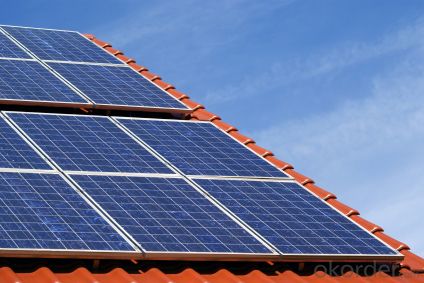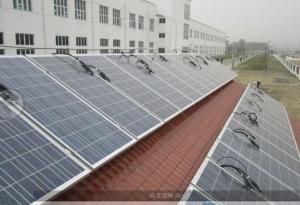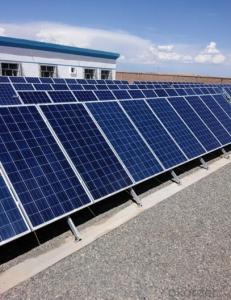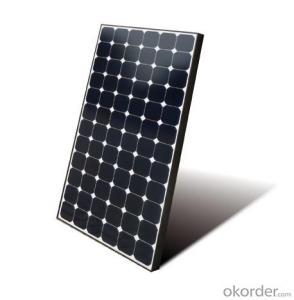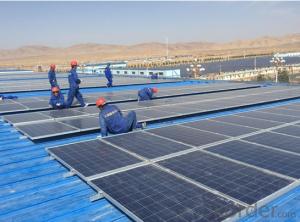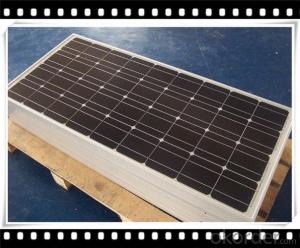285W Poly Solar Panel with Sunpower Maxeon Solar Cells - Factory Direct Sale CNBM
- Loading Port:
- Qingdao
- Payment Terms:
- TT OR LC
- Min Order Qty:
- 10 set
- Supply Capability:
- 300000 set/month
OKorder Service Pledge
OKorder Financial Service
You Might Also Like
Polycrystalline Solar Modules
CNBM offers a range of small, medium and large polycrystalline solar modules, designed for a range of requirements.
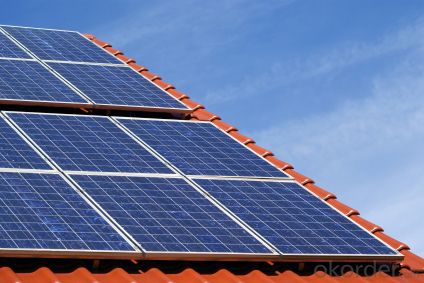
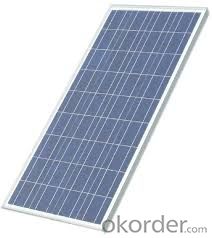
Specifications:
Tolerance | +/-3% |
Cell | Polycrystalline silicon solar cells (156 x 156mm) |
N0. of Cells | 60 (10 x 6) |
Dimension of Modules (mm) | 1650 x 990 x 40 |
Weight (kg) | 25.5 |
Limits:
Operating Temperature | -40~+85? |
Storage Temperature | -40~+85? |
Maximum System Voltage | 1000 VDC max. |
Hail Impact | Diameter of 28mm with impact speed |
Temperature and Coefficients:
NOCT | 48C+/-2? |
Voltage temperature coefficient (%/K) | -0.35 |
Current temperature coefficient (%/K) | 0.05 |
Power temperature coefficient (%/K) | -0.45 |
Characteristics:
Model: | SGM-200P | SGM-210P | SGM-220P |
Max-power voltage Vmp (V) | 29.2 | 29.4 | 29.41 |
Max-power current Imp (A) | 6.85 | 7.14 | 7.48 |
Open-circuit voltage Voc (V) | 36.5 | 36.69 | 36.9 |
Short-Circuit Current Isc (A) | 7.28 | 7.6 | 7.93 |
Max-power Pm(W) | 200 | 210 | 220 |
Model: | SGM-230P |
Max-power voltage Vmp (V) | 29.8 |
Max-power current Imp (A) | 7.72 |
Open-circuit voltage Voc (V) | 37.31 |
Short-Circuit Current Isc (A) | 8.19 |
Max-power Pm(W) | 230 |
STC: Irradiance 1000W/m2, module temperature 25?, AM-=1.5
Poly Crystalline Solar Panels Specifications Range
Maximum Power (Pm) | Dimension | Weight | Operating Voltage (Vmp) | Operating Current (Imp) | Open Circuit Voltage (Voc) | Short Circuit Current (Isc) |
0.45W | 140x80x10mm | 0.08kg | 3.3V | 150mA | 4.6V | 160mA |
1.0W | 162x140x10mm | 0.16kg | 7.5V | 150mA | 10.3V | 160mA |
4.5W | 269x251x23mm | 0.8kg | 16.5V | 0.27A | 20.5V | 0.3A |
10W | 420.1×268.9×22.6mm | 1.92kg | 17.5V | 0.58A | 20.5V | 0.6A |
20W | 425x502x50mm | 3.0kg | 16.8V | 1.19A | 21.0V | 1.29A |
30W | 593x502x22.6mm | 3.9kg | 16.8V | 1.78A | 21.0V | 1.94A |
40W | 655x537x50mm | 5.75kg | 17.3V | 2.31A | 22.1V | 2.54A |
50W | 839x537x50mm | 6.0kg | 17.5V | 2.9A | 21.8V | 3.17A |
65W | 1111x502x50mm | 7.2kg | 17.6V | 3.69A | 22.1V | 3.99A |
80W | 1204x537x50mm | 7.7kg | 17.6V | 4.55A | 22.1V | 4.8A |
- Q: Can solar cells be used for powering water treatment plants?
- Yes, solar cells can be used for powering water treatment plants. Solar energy can be converted into electricity through photovoltaic panels, which can then power the various processes involved in water treatment, such as filtration, disinfection, and pumping. Solar-powered water treatment plants offer a sustainable and renewable energy solution, reducing reliance on traditional power sources and contributing to a greener and more environmentally friendly approach to water treatment.
- Q: What is the impact of fire hazards on solar cells?
- Fire hazards can have a significant impact on solar cells, as they are highly susceptible to damage and destruction when exposed to fire. The extreme heat generated by fires can melt or deform the delicate components of solar cells, rendering them useless. Additionally, smoke and soot particles can accumulate on the surface of solar panels, reducing their efficiency by blocking sunlight. Therefore, fire hazards pose a serious threat to the functionality and lifespan of solar cells.
- Q: How can solar cells be used in residential applications?
- Solar cells can be used in residential applications by installing them on rooftops or in open spaces to harness sunlight and convert it into electricity. This electricity can then be used to power various household appliances and lighting systems, reducing reliance on traditional energy sources and potentially lowering electricity bills. Additionally, excess electricity generated by solar cells can be stored in batteries or fed back into the grid, further promoting sustainability and energy independence for residential properties.
- Q: Can solar cells be used in sports stadiums or arenas?
- Yes, solar cells can be used in sports stadiums or arenas. They can be installed on the roofs or other suitable areas to generate renewable energy that can be used to power various systems within the facility, such as lighting, scoreboards, or even charging stations for electric vehicles. Additionally, solar cells can help reduce the environmental impact of these large venues by decreasing their reliance on non-renewable energy sources.
- Q: What is the environmental impact of manufacturing solar cells?
- The manufacturing of solar cells has both positive and negative environmental impacts. On the positive side, solar cells generate clean and renewable energy, reducing the reliance on fossil fuels and thereby decreasing greenhouse gas emissions and air pollution. Additionally, solar cells have a long lifespan and require minimal maintenance, reducing the overall environmental impact compared to other energy sources. However, the production process of solar cells does have some negative environmental consequences. The extraction of raw materials, such as silicon and rare earth metals, can lead to habitat destruction, water pollution, and soil degradation. The manufacturing process also requires energy and water, which can contribute to carbon emissions and water scarcity if not managed efficiently. Overall, while the production of solar cells does have some environmental impacts, it is important to consider them in relation to the significant environmental benefits that solar energy provides in terms of reducing carbon emissions and mitigating climate change.
- Q: Can solar cells be used in water purification systems?
- Yes, solar cells can be used in water purification systems. Solar-powered water purification systems utilize solar energy to power the required processes, such as filtration, disinfection, and desalination. Solar cells can generate electricity from sunlight, which can be used to power pumps, UV lamps, or other components of the water purification system. This sustainable and environmentally friendly approach is particularly useful in areas with limited access to electricity or in off-grid locations.
- Q: Can solar cells be used in desert areas?
- Yes, solar cells can be used in desert areas. In fact, desert regions are ideal for solar energy production due to their high levels of sunlight and low cloud cover. The arid conditions also help keep solar panels clean and free from debris, maximizing their efficiency.
- Q: Is it complicated to make a solar cell work well?
- For the professionals, it is not complicated at all.
- Q: Can solar cells be used in powering drones?
- Yes, solar cells can be used in powering drones. Solar panels can be mounted on the surface of drones to convert sunlight into electrical energy, which can then be used to power the drone's motors and other electronic components. This enables longer flight times and reduces the reliance on traditional battery power. However, the efficiency of solar cells and limited surface area on drones may present challenges in generating sufficient power for certain drone applications.
- Q: What is the expected degradation rate of a solar cell?
- The expected degradation rate of a solar cell can vary depending on various factors such as the quality of materials used, manufacturing processes, and operating conditions. On average, solar cells can experience a degradation rate of around 0.5-1% per year. However, with advancements in technology and better quality control measures, modern solar cells are designed to have lower degradation rates, often below 0.5% per year, ensuring their longevity and efficiency over time.
Send your message to us
285W Poly Solar Panel with Sunpower Maxeon Solar Cells - Factory Direct Sale CNBM
- Loading Port:
- Qingdao
- Payment Terms:
- TT OR LC
- Min Order Qty:
- 10 set
- Supply Capability:
- 300000 set/month
OKorder Service Pledge
OKorder Financial Service
Similar products
Hot products
Hot Searches
Related keywords



